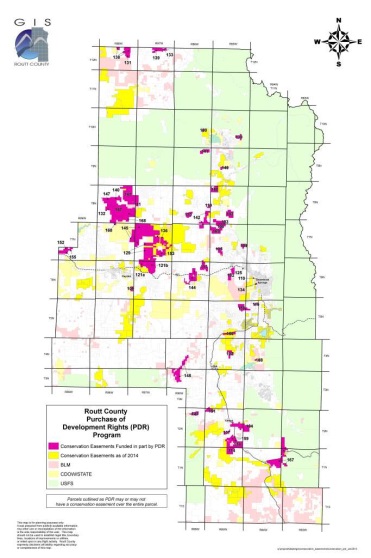Table of Contents


A conservation easement is a specific type of restriction placed on land to protect open spaces and sensitive resources, such as areas prone to hazards. An easement limits the ability to use or develop the land in some way, while still allowing the property owner to live on and use the land, sell it, or pass it on to her heirs. The property is legally protected, usually permanently, from certain types of uses or development that would harm the resources being protected. Conservation easements have been used widely throughout Colorado to protect a variety of resources such as riparian areas, scenic views, farm and ranch land, wildlife habitat, and historic buildings. They are a good tool for communities that have identified specific privately owned areas for natural resource protection, hazard mitigation, watershed protection, open space, parks and recreation, or other public benefit.
Implementation of conservation easements requires collaboration between local governments, land trusts, and the owners of the property to be protected.
Conservation easements essentially involve private contracts, not public land use controls. Thus, in many communities land trusts lead the way in setting up conservation easements, rather than local governments. Land trusts also typically have more resources readily available to establish and monitor easements, such as staff to monitor development activity and funding for carrying out the transactions. That is not to say that local governments cannot establish their own conservation easement programs. It simply requires a higher level of capacity to do so, and it is often easier for communities to coordinate with land trusts to maintain the easements. Some steps that can be taken by local governments to implement conservation easements include: mapping high-hazard areas, then identifying and partnering with a local land trust (often by approaching an organization such as the Colorado Coalition of Land Trusts), and then approaching landowners in high-hazard areas to gauge interest in establishing easements.
In 2003 Colorado Springs coordinated with its Cedar Heights subdivision and a local land trust to protect a 295-acre park with a conservation easement to prevent any new residential development and create an open space buffer between the Pike-San Isabel National Forest and the community. The easement allowed for fire mitigation work to take place on 100 acres of the park which, in combination with defensible space around homes, was credited with helping to save the neighborhood from the 2012 Waldo Canyon Fire (League, 2012).
Some of the benefits of implementing conservation easements include:
- Provides a beneficial way to preserve private lands with intrinsic public value or hazard risk without the need to acquire or further regulate.
- Provides income tax and estate tax benefits for landowners.
- Provides a relatively inexpensive way to meet community goals for open space, hazard mitigation, parks and recreation planning, etc.
Implementation of conservation easements can be cumbersome as there are many different players involved including, but not limited to, the landowner (and their families), community officials, land trust staff, realtors, and lawyers. Some conservation easements also require payment, which requires a dedicated funding source to administer. Tracking and monitoring CEs for compliance can involve staff resources. It is important to develop an adequate system for monitoring so development proposals and actions are consistent with the easements.
